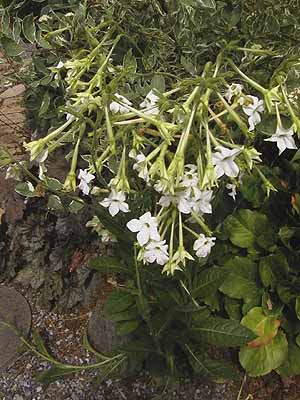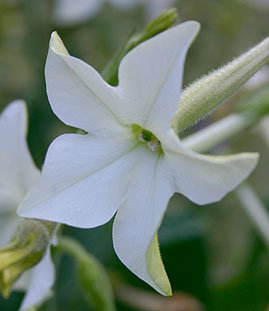Nicotiana alata
FLOWERING TOBACCO
syn. N. affinics
Family: solanaceae
Pronounced: nih-koe-shee-AY-nuh ah-LAH-tuh
Quick Jumps
Growing Guide
Rainy Side Notes
GROWING GUIDE

Origin:
Brazil and Argentina.
Plant Group:
Short-lived perennial treated as an annual.
Hardiness:
Sunset zones: All.
USDA zones: 10-11.
Mature size:
Height: 3-5 feet (90 cm — 1.5 m).
Width: 12 inches (30 cm).
Flowering period:
Summer to fall.
Flowering attributes:
Racemes of tubular, with funnel-shaped opening, white, fragrant flowers.
Leaf attributes:
Ten-inch long, ovate, green leaves at the base of plant; smaller leaves to the top. Leaves are sticky to the touch.
Light:
Full sun to partial shade.
Soil:
Moist, well-drained fertile soil is best, but N. alata will grow on a variety of soils.
Feeding:
Add a complete organic fertilizer when planting.
Propagation Methods:
Sow seed in situ in spring.
To get an early start, sow seed indoors in April. Cover seed lightly. Germinate at temperatures of 68-72° F (20-22° C). Germination will normally occur within 10-14 days. Harden seedlings off and plant outdoors after last frost.
Pruning:
Deadhead spent flowers to keep the plant producing more.
Pests and Diseases:
Susceptible to mosaic virus. Aphids may be a problem, although I have seen no problems with mine for the many years I have grown them in two different gardens located in the Pacific Northwest.
Rainy Side Notes

Nicotiana is named after Jean Nicot, a 16th century French consul, who introduced the plant to France. Alata means winged, after the petioles of the flower. Like Nicotiana sylvestris, moths pollinate the white tubular flowers. The leaves and stems are sticky to the touch; small insects stick to the leaves, like a fly on flypaper.
Nicotiana alata has a rangy look to it, but what it lacks for in beauty as a plant, it makes up for in fragrance! The flowers give off a sweet scent in the evening. Hybrids of this species, which were bred for color, are much less fragrant. If you do not like the look of the plants but enjoy their fragrance, hide their rangy bodies behind other plants or at the back of the border. For the evening aroma to reach into your home, plant them close to windows.
USDA zones indicate the species are not hardy in the Pacific Northwest; yet in both protected and unprotected parts of the garden, they come back every year for me. Start seed early and plant out transplants after hardening them off and danger of frost is past. N. alata is a good cut flower.
All parts of the plant are poisonous.
Debbie Teashon
Photographed in author's garden.

Gardening for the Homebrewer: Grow and Process Plants for Making Beer, Wine, Gruit, Cider, Perry, and More
By co-authors Debbie Teashon (Rainy Side Gardeners) and Wendy Tweton
Copyright Notice | Home | Search | Annuals

